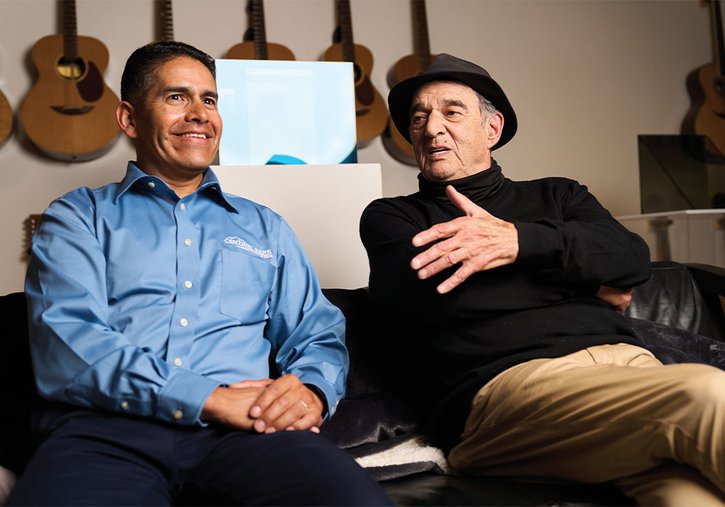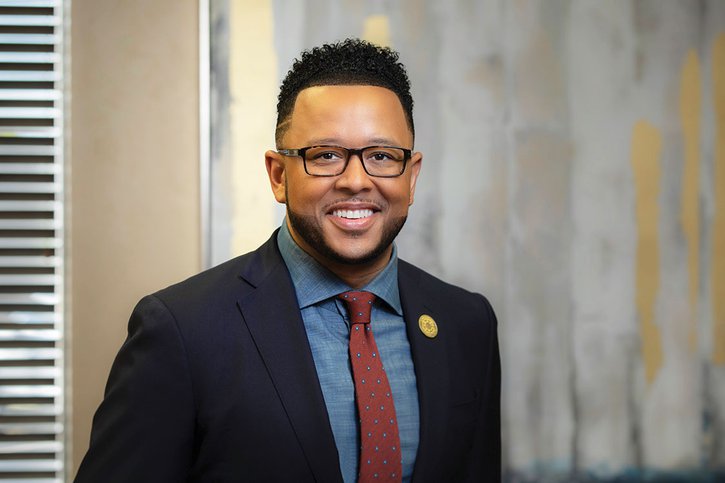Larry Bell’s dream of raising a family while working in Taos, New Mexico, was taking shape.
A team of professionals was transforming a crumbling, vacant building that once housed a commercial laundry into a studio for the contemporary artist and sculptor.
“At a certain point I realized I had been writing checks to local fabricators, builders and providers here and I hadn’t deducted those checks from the money I had in the bank,” Bell said.
Bell, fearful of bouncing checks throughout a community where he was a newcomer, rushed to his bank for help. He got it.
“Because of what I thought was either extremely good banking or just kindness to a stranger, they helped us,” Bell said. “That really endeared me. I felt like I was wanted. I was a part of something bigger than just my own little scene.”
That was in 1973. Since then, Bell has become a renowned artist whose work is sold mostly in Europe, New York and Los Angeles. His bank is still Centinel Bank, a community bank based in Taos.
“I see them as part of my closest friends in town – not just bankers.”
Fewer pillars, but still standing tall
Community banks have experienced significant changes in the last 20 years, according to “Community Banks’ Ongoing Role in the U.S. Economy,” written by Matt Hanauer, Brent Lytle, Chris Summers and Stephanie Ziadeh. The authors are members of Surveillance and Risk Analysis at the Federal Reserve Bank of Kansas City.
Several factors have driven a decline in the number of community banks, the authors found. Among them are consolidation resulting from geographic deregulation, mergers and acquisitions to achieve economies of scale, bank failures, and a decline in new banks.
The number of community banks, defined as those with assets of less than $10 billion, have declined from just over 8,300 in 2000 to 4,277 as of June 2020.
The paper said community banks today account for only 40% of all bank branches, 14% of bank deposits, 18% of bank loans, and just over 13% of bank assets.
The remaining deposits, loans, assets and business are with noncommunity banks (those with assets of $10 billion or more), which, in June 2020, totaled 127.
While noncommunity banks have increased their dominance with wide geographic coverage and economies of scale, the paper said community banks remain crucial providers of credit and financial services to smaller, rural communities.
Community banks are prevalent in the seven states of the Federal Reserve’s Tenth District.
For example, in Kansas community banks are 85.7% of all bank branches and 73.5% of deposits of all bank branches. In Oklahoma, community banks are 79.4% of all bank branches and 61.7% of deposits at all bank branches. In New Mexico, 50.2% of all bank branches and 37.7% of deposits are community banks.
Colorado was the only state in the Tenth District where community banks were not more than 50% of all bank branches and more than 35% of deposits of all bank branches.
“In a lot of cases the bank is one of the few businesses in these small communities,” said Brent Lytle, a supervisory and risk specialist and one of the paper’s authors. And although these small, rural business districts might appear paltry, the area’s bank customers could be very active.
“There may be a lot of farmers being supported by that small community bank,” Lytle said. “That’s why they are there, why they are still in business.”
Angel Reyes, president and chief executive officer of Centinel Bank in Taos, agreed.
“I think how the fabric of a community bank is completely woven into every aspect of your community is the real strength of a community bank,” Reyes said.
“We are another mom-and-pop business that is helping other mom-and-pop businesses work through our economy.”
In Taos, like many other small communities, the economy isn’t very diversified, which can present challenges for a community bank.
“I’ve been at Centinel Bank for 26 years and the one thing I have recognized is that Taos is a tough place to make a living,” Reyes said. “There is not a diversified economic base and as I look at where community banks operate, it’s typically in rural areas where there is similar characteristics.”
“You have to be understanding of your marketplace and how businesses thrive, not only survive but thrive.”

Angel Reyes (left) of Centinel Bank in Taos, New Mexico, counts local artist and avid guitar collector Larry Bell as one of the bank’s longtime customers. Photo by Jason Collin
Solid relationships and business practices
It’s clear that community bankers understand their marketplaces and customers well, said Lytle, who started at the Kansas City Fed as a bank examiner and visited many rural farming communities.
“You would have a conversation with the bankers and they would know everything about their customer … about their kids, about their life, about their operations, about their ground and how it drained.”
What community bankers often do well, Lytle said, is collect what he called soft information.
“It’s information you can’t glean from a standardized document,” he said. “It’s something you can only understand by having a personal relationship with whoever you are dealing with. I always found that to be something that was very impressive – that these community bankers would just know their customer base so well.”
Knowing customers is also good business for a community bank, said T.W. Shannon, president and CEO of Chickasaw Community Bank in Oklahoma City.
Knowledge of the community means community bankers can make sound decisions when working with small businesses – mainstay customers for community bankers.
“We don’t necessarily have a formula or a neat little box that customers have to fit in,” he said.
Knowledge also helps in processing finance applications and making a decision that is respected by the customer.
“Very seldom do we say a flat no – usually it’s a ‘not right now, and these are the steps you need to take to get there’,” Shannon said.
“Our customers trust our banks because many of them have been with us since day one,” he added. “That level of trust means everything, particularly when you think the sky is falling, like everyone thought it might in 2020.”
Reyes agreed. Local knowledge gives community banks a strategic and competitive advantage, he said.
“Some of my best relationships are relationships where you can have that candid conversation and say ‘I don’t think we can get behind this one’,” Reyes said.
He added that prudence also is important. “I think that is the beauty in what we do. We try to find ways to help people. Sometimes it’s not the largest loan that makes a difference. In some cases, it’s just giving access to money so they can get their rent paid. It’s not always the big transaction.”
“Customers, we know them well because we take the time to know them,” Reyes said. “We are not a papermill, we are not somebody who runs three ratios. Often it is visiting with the customer and understanding what they are trying to get done.”

Chickasaw Community Bank CEO T.W. Shannon. Photo by David McNeese
A unique role in the pandemic
The effectiveness of how nimble community banks can be was evident with the rollout and implementation of the Paycheck Protection Program (PPP), a U.S. Small Business Administration-backed loan program that helped businesses during the pandemic.
Lytle said many big banks had to start from scratch, setting up systems to handle the loans, which caused crucial delays for customers.
“The community banks could just roll up their sleeves and get to work,” Lytle said.
Shannon said that was the case at Chickasaw Community Bank.
“One of reasons we were able to respond so quickly is because we know our customers. We are intrinsically involved in their businesses,” he said.
Once Chickasaw Community Bank took care of their customers, they networked so businesses in other communities – even as distant as New York City – knew the Oklahoma City-based bank could help with PPP funding.
The owners of three restaurants in Manhattan responded, connecting through another Chickasaw Community Bank client in New York City, an architectural and engineering firm that had been introduced to the bank through a CPA.
Regis Marinier said he and his partners first sought PPP funding – unsuccessfully – for their restaurants from the large banks they do business within New York City.
“The gates did not open for everyone at the same time,” Marinier said.
But Chickasaw Community Bank said yes – in both rounds of funding.
“I didn’t even bother asking my regular banks the second time around,” Marinier said.
Chickasaw Community arranged $4.5 million in PPP for the restaurants, which employ about 300 people. “I have nothing but praise to say about this bank,” Marinier said. “They have been our lifesavers. “It was a gift from above – from Oklahoma.”
Future of community banking
There are many challenges ahead for community banks, the KC Fed paper said.
In addition to competitive pressures from larger banking organizations, the paper said community banks will face challenges as a result of broader economic consolidation, changes in demographics – especially the aging of small, rural communities – and rapid advancements in financial technologies.
“I think the underlying issue is they need to stay on the forefront, or at least close to the forefront, of technology,” Lytle said.
Shannon said it is likely future technology will follow the same path of ATMs: Over time, the technology becomes more affordable, allowing the community banks to offer the same products as the larger banks and compete.
“I’d much rather be the most relationship-oriented bank that is responsive, who is nimble, who puts in the extra time with the customers, than the most technological advanced bank,” Shannon said.
“I’ve never been afraid of competition,” he added. “I know people have predicted that it will be tough for community banks, but I think the relationship piece of what we do is a distinguishing factor.”
Reyes added that it’s important for community banks to work on succession planning.
“Over time, there will be consolidation. There will be a lesser number of community banks,” Reyes said.
“I think the community banks that remain will have great impact in the marketplace and in the communities in the future. There is a lot of opportunity in this business and in America … to grow small businesses.
“That is where community banks thrive.”
FURTHER RESOURCES
Read the Economic Review article on community banks’ ongoing role in the U.S. economy.
